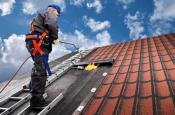Search
Login
Film for pools: characteristics, advantages, installation
The construction of a pool on its own site will require the solution of many problems related to determining the optimal shape, selecting the most suitable location, and choosing materials for manufacturing and cladding. When choosing cladding materials, it should be borne in mind that they should be quite practical in operation and provide the finished building with the most attractive and aesthetic appearance over a long period of time. One of the options popular today is the decoration of the pool with foil.
Content
- What is a film coating, its types video
- The main advantages of pool lining with foil
- Negative points
- Basic principles of material selection
- Basic requirements for surfaces to be coated with film
- Facing procedure video video
What is a film coating, its types

Consumers who have decided to cover the pool with foil can purchase two types of materials.
First - polyvinyl chloride film, which is a synthetic coating, the basis for the manufacture of which is plasticized PVC. The special treatment to which the material is subjected allows to prevent the development of fungal and bacterial organisms present in the pool water on it.

PVC film for pools can have different thicknesses: 0.5 mm, 0.8 mm, 1.0 mm, 1.2 mm. Experts recommend choosing a film thickness in accordance with the depth of the pool: the greater the depth, the thicker the film will be required for finishing work. Rolls of PVC film have a standard length of 25 m, its width can be 6.8 m or 2.4 m. The colors are quite diverse, which allows you to make a choice of material that matches the design decision of the structure. Using a film with an original pattern allows you to give the pool a fairly attractive and aesthetic look.

Second view - butyl rubber film for pools.
It has higher ductility and a long service life. It is simple and convenient to work with such material - it is well cut with ordinary scissors, its gluing allows you to create reliable and durable seams. Butyl rubber film is recommended for use in large structures requiring high strength coatings. Such a film withstands high pressure and seasonal temperature fluctuations. The material has a two-layer structure, this significantly reduces the likelihood of leaks and helps to extend the life of the coating.
The main advantages of pool lining with foil

- The unique multilayer structure of the material, the presence of reinforcing threads in it, ensures its extreme strength.
- A positive aspect of the use of most modern finishing materials is their versatility: the finishing film allows you to perform high-quality waterproofing of the artificial reservoir and create a decorative coating for it, and the shape of the pool, dimensions and type do not have special significance: such a film is used for a frame pool and for a stationary one.
- You can stick the film on the surface of any type: stone, plastic, concrete, metal, previously trimmed with tiles.
- The material does not collapse and does not change its characteristics from the effects of modern water care products, it is not exposed to microorganisms.
- High quality material allows you to maintain the tightness of the pool bowl even when cracks appear on it.
- Facing work can be done in a very short time.
- All kinds of shades of material and patterns allow you to create an attractive structure for the rest of children and adults.
- You can use the film in the restoration of old facilities and in the construction of new ones.
- The rough surface of the face layer provides a good anti-slip effect.
- Installation of the film for the pool can be done with your own hands, for this it is enough to carefully study the instructions, special preparation is not needed.
- An attractive moment is the low cost of the material, which allows you to update the old pool, or build a new one, with minimal cost.
Negative points
Unfortunately, most building materials, with all their attractiveness, may have some drawbacks. To avoid mistakes when choosing, it is advisable to take into account all the positive and negative points that may arise.
The service life of the film is 6 years. After the expiration of the term, it can change its shape, lose color brightness, in case of violation of the external waterproofing, bubbles can form under the film. During operation, under the influence of ultraviolet rays, the film above the surface of the water can become faded. Pools with a PVC film finish require preservation for the winter period, the film may collapse from exposure to low temperatures.
Basic principles of material selection

The first step is to clarify the amount that can be spent on the purchase of material. Naturally, having a larger amount you can count on the acquisition of better material. A thicker film will be required for installation on large pools with a raised bottom; for finishing small ponds, a film of smaller thickness can be used.
An important indicator of quality is elasticity: when stretched, such a material does not change its quality characteristics. It should not be forgotten that the duration of its service depends on the thickness of the material.
Basic requirements for surfaces to be coated with film
A high-quality result can be obtained only by observing the technology and the rules of the work. You should also pay attention to the quality of surfaces:
- there should be no bumps or bumps on the bottom surface,
- the sides of the pool should be strong,
- places of mating surfaces should be located at an angle of 90 degrees,
- if there are deviations along the vertical plane, then they should not exceed 3 mm,
- option for connecting embedded elements - flange,
- lining the sides with tiles is performed after installation of the film coating,
- it is necessary to take care of protection against groundwater - this will prevent a violation of the waterproofing qualities of the coating.
Facing procedure

In the process of facing the pool, you will need to perform several operations. First, the surface of the pool is prepared: in the case of roughness and roughness, grinding of the bottom of the pool will be required, in the case of potholes, they are putty. If there is a suspicion that these measures will not be enough, you will have to level the bottom surface. When aligning the sides, check that the applied putty layer does not peel off.
If the layer of the old finish holds tight, then the film can be glued directly to it. If the facing tile does not hold well - it is better to remove it completely.

At the next stage, the substrate is laid, it is designed to protect the film from rapid wear. The substrate to the walls is fixed with a special strip, then a film is welded to it. The fixing strip is a metal tape with a plastic coating. The length of the tape is 2 m, the thickness is 2 mm. Fasten it with screws. The sheets of the substrate should not overlap each other, this will prevent the appearance of wrinkles. When performing work, you can use elastic glue.

At the end of this stage, you can proceed to the direct finishing with a film. It should not be forgotten that the main goal is to create a sealed surface with an attractive appearance. The implementation of the gluing process will require accuracy, keeping surfaces clean. The place where the sheets are welded is quickly heated and tightly compressed to prevent the appearance of grooves.
The connecting seams are further treated with a special sealant.
After that, the pool is filled with water by approximately 0.3 m and the vertical film panels are pulled. Then the counter flanges of the embedded elements are mounted, after which the desired amount of water can be poured into the pool.
Water for the first filling of the pool should have a temperature of no higher than 40 degrees. After that, the finishing work can be considered completed.





